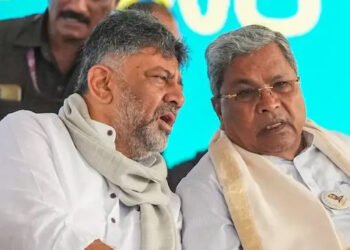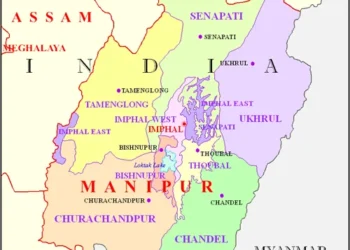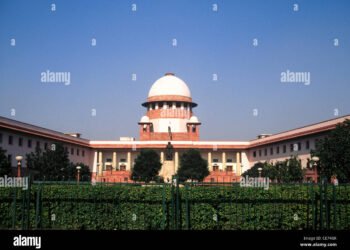BY PC Bureau
New Delhi, November 5:
In a political storm that refuses to settle, the Election Commission of India (ECI) is under increasing pressure to issue a categorical clarification after Rahul Gandhi’s explosive “H Files” disclosure, which alleged massive voter fraud in the 2024 Haryana Assembly elections.
During his Wednesday press conference, the Congress leader claimed that a Brazilian model’s photograph was used to create 22 voter identities, all registered under different Indian names and addresses, across multiple constituencies. Gandhi said this was “not an error, but a crime executed through software-backed manipulation.”
He demanded a forensic investigation into the rolls, alleging that 5.21 lakh duplicate voters, 93,000 invalid addresses, and over 19 lakh unverifiable new additions had tainted the mandate. “This is not a clerical mistake—it’s digital theft of democracy,” he said.
Holding up pages from the official voter rolls, Gandhi pointed to names like “Seema,” “Sweety,” “Rashmi,” and “Vimla” — all with the same face.
“This is not an error. This is a system failure — a theft of democracy using technology,” Gandhi said. “How can a foreign model’s photo be on Indian voter IDs? Who verified it? Who cleared it?”
READ:
LIVE: #VoteChori Press Conference – The H Files https://t.co/IXFaH9fEfr
— Rahul Gandhi (@RahulGandhi) November 5, 2025
A Pattern Too Perfect to Be Random
At the core of Gandhi’s charge is not just duplication but automation.
His team alleges that a centralised digital system, possibly aided by internal access, may have been used to generate fake voter IDs at scale, linking random names with cloned images to create phantom voters.
“Even if this Brazilian model never voted, her face did — again and again,” Gandhi said, suggesting the fraud might have been executed through a software-assisted operation that filled votes using machine-generated inputs rather than physical ballots.
Independent data analysts who reviewed parts of the dossier described the repetition pattern as “statistically implausible without automation.”
If true, this would mean that voting fraud extended beyond local booth-level manipulation into a coordinated digital breach — a scenario with serious national implications.
EC Avoids Specifics
The ECI dismissed allegations made by Rahul Gandh, asserting that no formal appeals or objections were filed by Congress representatives during the revision of electoral rolls.
According to Election Commission sources, only 22 election petitions are currently pending in the Punjab and Haryana High Court out of 90 Assembly constituencies — none of which relate to the alleged voter duplication issue highlighted by Gandhi.
In a strongly worded response, the ECI questioned the role of Congress polling agents and Booth Level Agents (BLAs) — party-appointed representatives tasked with monitoring voter rolls and raising objections in real time during polling and revision exercises.
The Commission said that no claims or objections were raised by Congress BLAs to prevent multiple entries or verify suspicious voter identities, nor did the party file any appeals or complaints during the roll revision process.
“Polling agents are the first line of defence against irregularities at the booth level. If they failed to object, it raises questions about whether these alleged cases were ever detected in the first place,” a senior official was quoted as saying.
The ECI also took exception to Gandhi’s assertion that duplicate or fake voters had cast their ballots for the BJP. The Commission reportedly remarked that there was no way for Gandhi to determine which party such voters supported, adding that, “They may well have voted for the Congress.”
Sources within the Commission clarified that the presence of voters with house number ‘zero’ on rolls does not indicate fraud, but rather refers to households awaiting formal numbering by local panchayats or municipalities.
Rahul’s Demand: EC Must Speak, Not Ask for Affidavits
The EC has officially asked Rahul Gandhi to submit affidavits substantiating his claims within seven days. But Gandhi and several opposition leaders argue that the onus lies squarely with the EC.
“If Rahul is wrong,” said a senior Congress leader, “then let the EC hold a press conference and categorically say — the Brazilian model never appeared in the voter rolls, no duplicate entries exist, and no machine tampering occurred. Otherwise, silence only deepens suspicion.”
The Congress has also demanded that the ECI publicly release scanned images of all voter ID photos flagged in The H Files, along with the original source metadata, to verify whether the model’s image was indeed used.
Election Commission’s Cautious Response
Questions the EC Must Answer
If Rahul Gandhi’s claims are false, then how did the same image surface 22 times?
Who verified the photograph when those voter IDs were issued?
Was there a manual verification process, or was it automated through Aadhaar-matching software?
How could such duplication pass through multiple checks at the state and national levels?
More critically, if this image was indeed taken from the public internet — as alleged by Gandhi — what safeguards exist to prevent the use of non-Indian or fabricated identities in the voter database?
One former Election Commission official told Power Corridors,
“The key question is not whether a Brazilian model voted, but whether anyone — or anything — voted using her face.”
Political Fallout and Public Reaction
The BJP has dismissed Gandhi’s revelations as “another election-time stunt,” accusing the Congress of undermining public faith in democratic institutions.
Union Minister Anurag Thakur said, “When defeated at the ballot, Congress invents conspiracies. Let Rahul Gandhi show one genuine voter with a Brazilian passport.”
Yet, several independent analysts and opposition leaders argue that the scale and specificity of Gandhi’s claims — including alleged patterns of duplication across other states — warrant at least a public clarification.
Social media platforms have exploded with debates under hashtags #HFiles, #VoteChori, and #BrazilianModelVote, with both outrage and ridicule flooding X (formerly Twitter).
Why Silence Isn’t an Option
The broader question now extends beyond Haryana. If a foreign image could enter official electoral databases, it raises systemic questions about data verification, EC accountability, and the security of digital democracy.
As one commentator noted, “Either Rahul Gandhi is lying, or the system has been hacked. There is no middle ground.”
If Gandhi’s claims are false, the Election Commission must come forward — not with notices, but with transparency.
If his claims are true, it signals one of the gravest electoral compromises in independent India’s history.
Until then, the face of a Brazilian model — replicated across India’s voter rolls — may remain the haunting emblem of an election under suspicion.












